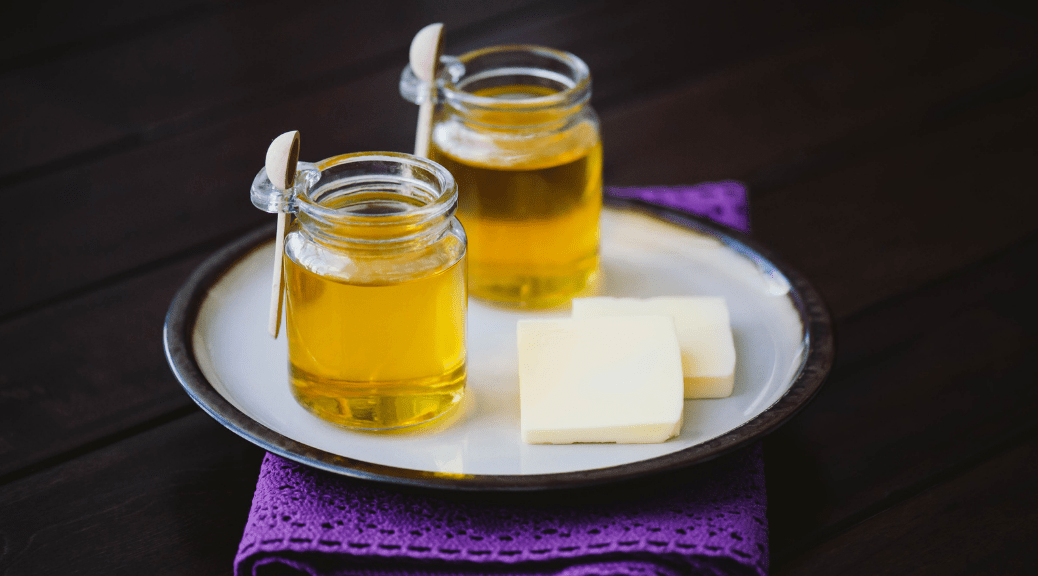Unravelling the Secrets of Ghee

With a fascinating history that spans through the ages, ghee goes beyond a mere addition to our plates—it demands our attention as discerning consumers. In this article, we will uncover its ancient origins, explore the diverse range of types available, and delve into the unique nutritive compositions that set them apart. Along the way, we will carefully evaluate the pros and cons of incorporating ghee into our diets, unveiling its potential health benefits and important considerations to keep in mind. Get ready to embark on a journey that will deepen your appreciation for this culinary gem, as we unravel the remarkable world of ghee.
Richa Pande
Ghee is a type of clarified butter that has been used for centuries in traditional cooking and healing practices. It is made by simmering butter to separate the milk solids and water, leaving behind a golden, pure fat with a rich, nutty flavour. Ghee is highly regarded for its high smoke point, which makes it ideal for high-temperature cooking. It is also known for its potential health benefits, such as being a source of some essential vitamins, aiding digestion, and potentially possessing anti-inflammatory properties.
Ghee has a fascinating history that spans centuries and traverses different cultures. Its origins can be traced back to ancient times, with early references found in Indian Ayurvedic texts dating back over 5,000 years. Ghee holds a prominent place in Ayurvedic medicine and Indian culinary traditions. It was revered as a sacred substance and was used for various rituals, as well as for its healing properties. Ghee’s popularity spread to neighbouring regions and cultures, including the Middle East and Southeast Asia. Over time, ghee became an integral part of many cuisines worldwide, celebrated for its flavour, shelf stability, and versatility. Its rich history and cultural significance have cemented ghee as a timeless ingredient, treasured for its culinary and holistic attributes.
Ghee is a versatile ingredient that offers a multitude of benefits. It serves as a rich source of fat-soluble vitamins which contribute to maintaining healthy skin, supporting immune function, and promoting good gut health. With its high smoke point, ghee can withstand high cooking temperatures without breaking down or producing harmful compounds, preserving its nutritional properties and imparting a delicious flavour to dishes. In Ayurvedic medicine, ghee has been used for its digestive benefits, stimulating the secretion of stomach acids and aiding in the digestion and absorption of nutrients. Its lubricating properties may also provide relief from constipation and promote regular bowel movements. Ghee contains butyric acid, a short-chain fatty acid known for its potential anti-inflammatory properties. This can be particularly beneficial for individuals with inflammatory bowel diseases, as well as the omega-3 and omega-6 fatty acids present in ghee. Furthermore, ghee is lactose-free and shelf-stable, making it suitable for those with lactose intolerance and offering a longer shelf life compared to butter. Last but not least, ghee adds a delightful, nutty flavour to both sweet and savoury recipes, enhancing the overall culinary experience with its unique aroma and taste.
Buffalo Ghee
Buffalo ghee is a type of clarified butter that is derived from the milk of buffaloes. It is highly regarded in various culinary traditions, particularly in South Asian and Middle Eastern cuisines. Buffalo ghee has distinct characteristics that set it apart from other types of ghee. Buffalo ghee is known for its rich and intense flavour profile. It has a strong, slightly tangy taste that adds depth and complexity to dishes. The aroma of buffalo ghee is robust and distinctive, often described as earthy and nutty. In terms of its nutritional composition, buffalo ghee is a source of fat-soluble vitamins. It contains higher levels of fat compared to other types of ghee, making it a dense and energy-rich ingredient.
Cow Ghee
Cow ghee is a type of clarified butter made from cow’s milk. It holds a prominent place in various culinary traditions, particularly in South Asia. Cow ghee is widely valued for its unique flavour, rich aroma, and numerous potential health benefits. To make cow ghee, butter is traditionally prepared from cow’s milk, which is then heated and simmered to remove the water content and separate the milk solids. The resulting golden liquid is strained, leaving behind pure cow ghee. One of the distinct characteristics of cow ghee is its mild and subtle flavour profile. It has a delicate, buttery taste with a hint of nuttiness. This makes it a versatile ingredient that can enhance the flavours of both sweet and savoury dishes.
Bilona Ghee
Bilona ghee is a traditional and artisanal form of ghee-making that has been practiced for centuries. It involves a meticulous process where curd made from whole milk or cream is hand-churned using a wooden churner or bilona. The manual stirring or whisking of the curd helps separate the butterfat from the buttermilk. The separated butter is then slow-cooked over a low flame, allowing the milk solids to caramelize and settle at the bottom. This slow-cooking process imparts a distinct aroma, rich flavour, and golden colour to the ghee. Bilona ghee is highly regarded for its superior taste, nutritional benefits, and the traditional craftsmanship involved in its production. It is cherished for its purity, quality, and the traditional touch it adds to dishes. The labour-intensive and time-consuming nature of bilona ghee-making makes it a revered and sought-after product, appreciated by those who value the authentic and artisanal approach to ghee production.
Grass-fed Ghee
Grass-fed ghee is a type of ghee made from the milk of cows that are raised on a natural diet of grass and pasture. Unlike cows that are fed grains or confined to feedlots, grass-fed cows produce milk that is rich in essential nutrients and beneficial compounds. One notable advantage of grass-fed ghee is its higher content of vitamin K2, a fat-soluble vitamin that plays a crucial role in bone health, cardiovascular health, and proper calcium metabolism. Vitamin K2 is found in greater quantities in the milk and butterfat of cows that graze on fresh, green grass. By consuming grass-fed ghee, individuals can potentially increase their intake of vitamin K2, which is known to have important health benefits. Grass-fed ghee not only offers the traditional qualities of ghee, such as a high smoke point and rich flavour, but also provides an additional nutritional advantage through its naturally occurring vitamin K2 content.
A2 Ghee
A2 ghee is often marketed as a healthier alternative to regular ghee, claiming to be made from the milk of cows that produce A2 type beta-casein protein. However, the notion that A2 ghee is superior is largely a misleading marketing strategy that preys on consumer concerns. Firstly, ghee, by its very nature, is clarified butter where the milk solids, including proteins, are removed during the manufacturing process. This means that ghee, regardless of the type of milk used, contains negligible to no protein content. Therefore, claims about A2 protein in A2 ghee are baseless. Furthermore, the exaggerated prices of A2 ghee compared to regular ghee only add insult to injury. Consumers end up paying more money for a product that offers no significant nutritional advantage or health benefits.
Herbs and Spice Induced Ghee
Adding herbs and spices to ghee is a popular practice that enhances both the flavour and potential health benefits of this versatile ingredient. Turmeric ghee combines the anti-inflammatory properties of turmeric with the nutritional richness of ghee. Brahmi ghee may support cognitive function and memory. Garlic ghee infuses the distinct flavour and potential immune-boosting properties of garlic. Shatavari ghee is believed to promote hormonal balance and female reproductive health. Ashwagandha ghee is known for its adaptogenic properties, potentially reducing stress and promoting overall well-being. Incorporating these herbal-infused ghee variations into your diet can be a flavourful and convenient way to enjoy their potential health benefits.
Smart Consumer Practices: Tips for Buying and Handling Ghee
When purchasing, handling, and consuming ghee, there are several important tips that consumers should keep in mind to ensure they make the best choices and derive maximum benefit from this versatile ingredient. Here are some essential consumer tips:
Quality and Purity
Look for ghee that is made from high-quality ingredients, preferably sourced from organic, grass-fed, or pasture-raised cows. Check for certifications or quality seals to ensure the authenticity and purity of the product.
- AGMARK Certification:AGMARK is a quality certification mark issued by the Agricultural and Processed Food Products Export Development Authority (APEDA). It verifies the quality and purity of ghee products according to specific standards, including fat content, acidity, and sensory parameters.
- ISO Certification: Ghee manufacturers can obtain ISO certification, which demonstrates compliance with international quality management system standards. ISO certifications such as ISO 22000 or ISO 9001 indicate that the production processes, quality control, and food safety measures are well-established and maintained.
- Organic Certification:Organic ghee can be certified by organizations such as the National Programme for Organic Production (NPOP) or the Agricultural and Processed Food Products Export Development Authority (APEDA). Organic certification ensures that the ghee is made from organic milk obtained from cows raised without the use of synthetic chemicals, hormones, or antibiotics.
Packaging
Choose ghee that comes in airtight, light-proof containers to preserve its freshness and prevent oxidation. Glass jars or tin containers are preferred over plastic containers, as they are less likely to interact with the ghee.
Storage
Store ghee in a cool, dry place away from direct sunlight. Refrigeration is not necessary, as ghee has a long shelf life due to its low moisture content. However, if you live in a hot climate, refrigeration can help maintain its quality.
Handling
Use clean, dry utensils to scoop or measure ghee. Avoid introducing moisture or contaminants into the container to prevent spoilage.
Cooking Temperatures
Ghee has a high smoke point, making it suitable for high-heat cooking methods such as sautéing, frying, and roasting. However, avoid overheating or burning ghee, as it can lead to the formation of harmful compounds. Use medium to low heat for longer cooking durations.
Portion Control
Ghee is calorie-dense, so it is important to consume it in moderation. Consider your dietary requirements and consult a healthcare professional if you have specific health concerns.
Always Read Food Labels
Reading labels empowers consumers to be aware of the nutritional content of products and make conscious decisions that positively impact their health and well-being. Consumers must be vigilant and prioritize reading food labels, specifically comparing the values of saturated fats and polyunsaturated fatty acids (PUFA).Pick a brand with lesser saturated fats and more PUFA content.
Related
Unmasking Air Pollution’s Impact on Pulmonary Health
Over the past few decades, air pollution and climate change have become major global concerns. Air pollution has many detrimental effects that pose...
Cracking Cheese Codes: Healthy Choices, Labels, and Storage Tips
Cheese is a creamy, tangy, versatile delight that can elevate any dish and melt our hearts and taste buds in seconds. However, it is often thought...
Navigating Consumer Challenges in India: Implementing Effective Measures
In the diverse and vibrant landscape of India, consumer-related issues have emerged as a critical facet of daily life. As the nation progresses...



